
Why Mow It?
Did I tell you, Reader, that Jerod keeps his bees at his grandparents’ place where there is quite a bit of open land and a couple of massive gardens? Earlier this week, Jerod took me for a stroll into the thick weeds of the open lot—once the bees arrived last spring, Jerod’s grandfather stopped all mowing in the back lots, and now it’s full of glorious weedy delights. And the bees are hog wild on the flowers. I don’t know why we mow our yards. I’m of a mind to let some of our lawn go.

"Is it worse to be scared than to be bored, that is the question."—Gertrude Stein
I resigned from my job. I resigned from my job without a plan for another. I think I may be finished working for other people. I am trusting the universe on this one, and so I’m focused squarely on the bees. The bees are in front of me right now, and I’ve learned to handle what’s in front of me without looking too far ahead and borrowing trouble. This should lead to something. Right, Reader?
Each day that I’ve been free from the old job, I’ve accomplished at least one thing to move TwoHoneys Bee Co. toward a business that will employ me full time. And wouldn’t it be great if TwoHoneys could eventually employ more people, too: students, interns, apprentices, carpenters, contractors, web masters, designers, marketers. I like it.
I envision teaching a university-based, experiential-learning beekeeping course…a writing course…a course in composition; then, I envision taking that course abroad…say, to Kenya or Tanzania to learn how people in Africa work with and earn a sustainable living with Africanized bees.
I see myself in a small storefront operation. A storefront well lit with natural light. And bare, wooden floors (I’ll want to walk around barefoot on those floors in the summertime). Walls filled with jars of honey and beekeeping equipment. A few beehives out back. I’ll drive an old pick-up truck with TwoHoneys Bee Co. painted on the doors. People will call me the Bee Lady. People will say, “Call her. She’ll do it.” I will respond, “Yes” when called. I will figure out a way.
A Space Is Prepared, and the Bees Fill It
We spent much of the weekend on our farm in Waco, Kentucky. Now that Deb owns the farm outright, we feel we can begin making a few slight changes in the way things work down there. For instance, I think we’re gonna ask all the relatives to come and get whatever they want from the old farmhouse and the shed and the barn; whatever’s left that we don’t want will go up in flames in a bonfire the likes of which Madison County hasn’t seen in a long long time. Keep your eyes on the sky the day following Labor Day.
Why clear all that stuff from the house, the shed, the barn? Sometimes you just need to make some room. Creativity requires room. How can new things come to you, Reader, if there’s no space in which to hold it?
So, Brent (the guy who leases the farm to run some cattle) has recently changed his life. He’s made room in it for new things, and he’s ready to keep bees. We’re thinking of starting about 10 hives down there next spring. The farm is a 2-hour drive from here, and because we get down there only about once a month, it’s important to have someone keeping an eye on the bees…and Brent seems perfectly delighted at that prospect. He’s decided on a spot against a fence for the hives. He’s planning to seed a field in clover. For whatever reason, a reason I have no need to understand, Brent needs bees. Just as I did.
You know, Reader, I find it quite fascinating that some people—people such as Brent and me (and perhaps even you)—become ready. I don’t know how to describe it, but I can spot it right away. A light appears in the eye. A space is held open in the body for it. Other people make polite conversation, but those who are ready cannot be satisfied with small talk. Might as well go ahead and buy those people a smoker of their own.
A Smoker Sets the Tone
You should smell my car. Well, first you should know that I drive a 12-year old Nissan Pathfinder (it has over 160K miles on it, but I’m not giving it up…I figure I can get 250K miles out of it. I don’t quit on things).
My car smells like smoke and beeswax, and it’s a joy to sit in when I’ve been visiting beeyards. Why? Because the smoker’s still smoldering in the car, and I often have some freshly used frames of beeswax in there with me.
So, let’s talk about the smoker—which is the single most important tool when it comes to keeping bees. Even those beekeepers who don’t routinely wear veils use smoke. I’ve never met a beekeeper who doesn’t have a smoker lit and ready to use when visiting the bees, and I probably wouldn’t work with one who didn’t.
And wouldn’t you know it? The single most important beekeeping tool is also one of the most pleasant and sensory to use…but it’s also (initially) a pain in the neck. It takes some time and some attention (and some experience) to get a smoker properly puffing away…and I admit, it’s tough to carve out the necessary time and attention when you’re in a rush to open a hive. Frankly, I’ve come to think of lighting the smoker and nurturing the smoke from it as a sensory way to transition from the rush rush rush of daily life to the calmer behaviors appreciated by the bees.
You want to know why beekeepers use smokers, don’t you, Reader? Well, the short of it is this: Beekeepers announce their arrival at the hive by puffing a bit of smoke into the hive entrance and under the lid. This announcement leads the bees to think there may be fire in the area, so they begin the process of engorging with honey in the event they must leave to find a new place to live. And when bees eat honey, they become calm. A bee filled with honey does not want to sting. However, in the event a bee didn’t get the message and does sting, the smoke serves to mask the alarm pheromone (emitted at the time of the sting) that signals other bees of danger; so, it reduces the chances of more stings.
We keep the smoker lit and puffing away in the event the bees become agitated. A little cloud of cool smoke settles everyone down…including the beekeeper who, when she operates those billows, feels as if she may have some sort of control over the world. Which she does not have at all. But it smells nice and looks cool.
All of this to say that I’m now using a new smoker—a Rauchboy. From Germany. It looks awesome and smolders like crazy. It’s a little more expensive than the run-of-the-mill smokers, but I want mine to stand out in a crowd. I’ve kept it lit in the backyard just for the heck of it…just so it can hurry up and get its patina on.
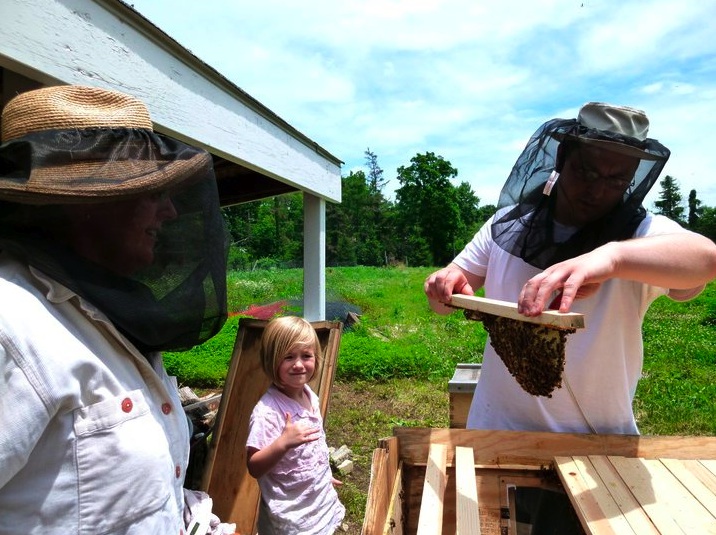
My Beekeeping Hat
I’m on a quest. I’m on a quest to find a hat and a veil that I like and that suits my style. I’m not sure why I’m not satisfied with the typical beekeeping hat and veil, but I’m not.
Requirements:
- I want a straw hat. I don’t know why, I just do. Accept it.
- The hat has to have a wide brim…3-4 inches wide (which will hold the veil away from the face. If the veil rests against the face, a bee can sting the skin right through it).
- The hat brim has to be firm enough to carry the weight of the veil. No, the veil isn’t heavy, but it does pull at the brim a little bit. My current favorite hat (and the one I thought I’d love forever) is made of raffia…and the weight of the veil over the course of this season has led my favorite hat to droop. We can’t have that, can we, Reader? It makes me look droopy. And I look droopy enough already.
- The hat needs to hold up to a good deal of sweat and a certain amount of beating. I throw it in my car a lot. And then I throw other things on top of it. The raffia rated high in this area (however, this “give” quality may also be the reason for its droopy demise). The typical pith helmet rates high in this category, but I don’t love that one. Yes, it would be easier if I did. Maybe I should try the pith helmet again (I have two of them already, for crying out loud)…it fulfills almost all of my requirements. Shit.
Right now I’m wearing a Tilly hat, but it’s not straw. The Tilly hat is fine, but I don’t look the way I want to look in it, you know?
Oh, and did I tell you? I ordered a wonderful, wide-brimmed straw hat online from Gempler’s, but it was too big (to compound the problem of my search, I have a very tiny head). When I tried to return it, Gempler’s said they would simply refund the money (because it cost too much for them to ship back and forth! I love this wonderful policy), and that I should give the hat to someone who could use it. Is that the greatest thing ever?!
Next thing I know, Deb is wearing my new hat to mow the lawn. And she looks like a million bucks in it. Just the way I wanted to look. So now Deb has a wonderful, new, wide-brimmed straw hat. And, wouldn’t you know it, they don’t make it in a small. Which is one huge obstacle to my hat shopping.

A Brood Frame Free of Nurse Bees
This is a frame of brood brushed free of its usual attending nurse bees. I’d brushed the bees off because I removed this frame from the Nicola hive (which lives in my beeyard)—named in honor of Nicola Mason’s first swarm capture—and I’d given it to a hive that currently lives in Nicola’s apiary, the Bebe hive. Why did I make that swap? Because the Bebe hive started out as a tiny, queenless hive and lacked the resources from which to make a new queen.
Giving a queenless colony comb containing either eggs or larvae (4-days old or younger) from another hive allows the bees in the queenless hive to make a queen from the donated eggs or larvae. So, it’s handy when beekeepers have other colonies from which to draw these resources…which is one reason most new beekeepers are encouraged to keep at least two colonies. Without another resource, colonies often fail.
If the Bebe bees choose to make a queen from the frame shown above, then their queen will be the genetic daughter of the queen laying in the Nicola hive…and the entire Bebe colony will eventually take on the characteristics of the very calm and productive Nicola colony.
In the image above, this is what you see (from bottom to top):
- empty cells (in the lower right-hand corner and across the bottom)
- larvae (the “C”-shaped, white, wormy things. It’s called “larvae” until it’s capped)
- capped brood (the lighter the capping, the younger the pupa. Once it’s capped and before it emerges, it’s called “pupa”)
- the empty cells spotting the capped brood? Cells from which young bees have already emerged. And that cell will forever be darker than the cells which never contained brood.
- You see more larvae in the upper left-hand corner. A good-laying queen lays her eggs in a circular pattern starting from the center and working her way out, so it stands to reason that larvae around the edges are in similar developmental stages. Yep, this is a good queen.
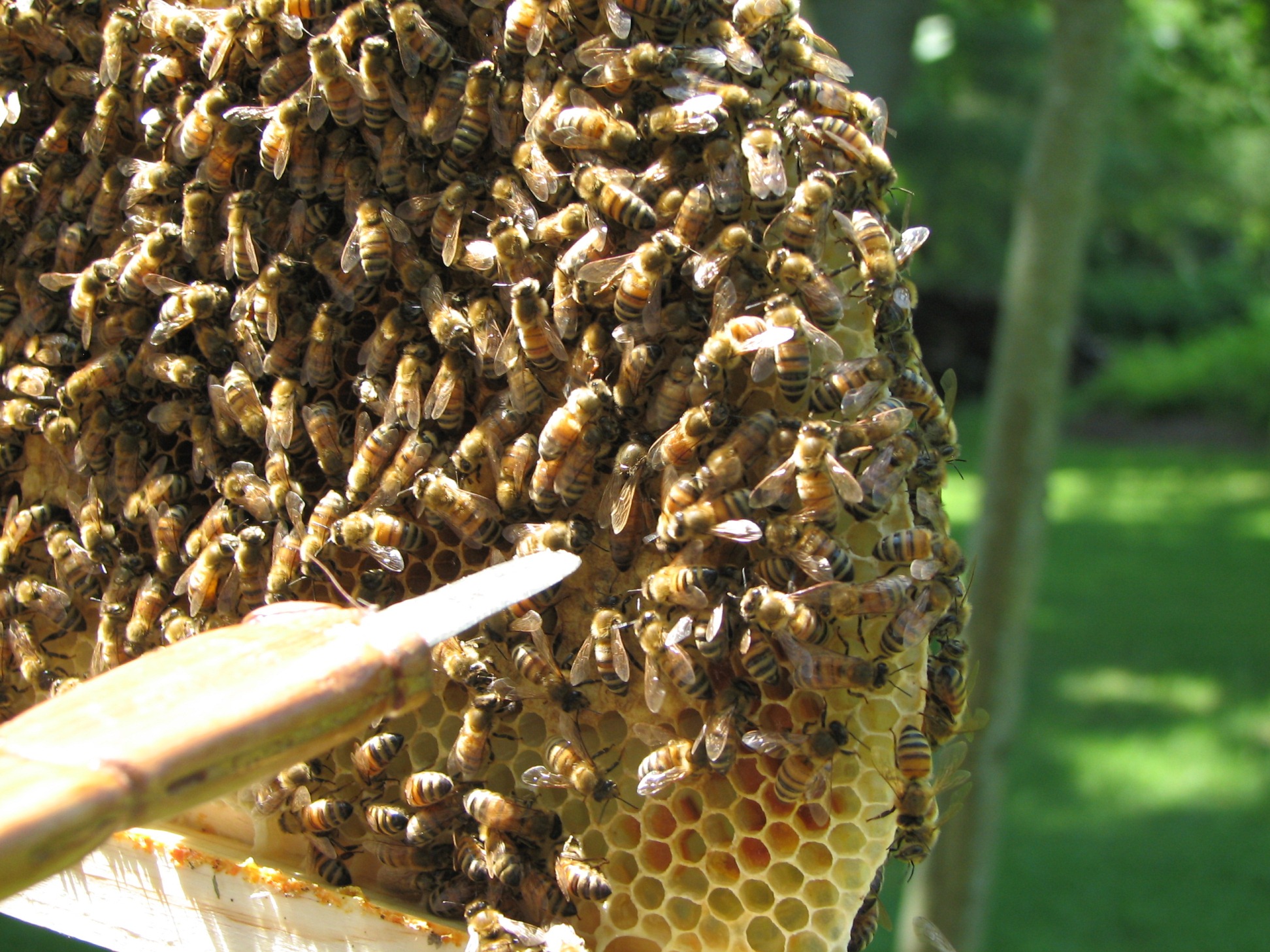
Nice Work, Soapbox Cincinnati!
If you’ve come to TwoHoneys via Elissa Yancey and Summer Genetti‘s wonderful Soapbox Cincinnati feature about Cincinnati’s urban beekeeping, then you may be surprised to find only this blog alive here.
The TwoHoneys Bee Company site is undergoing some changes, and you can’t see it yet (but I invite you to “like” the TwoHoneys Facebook page where you can keep up with our bee stewards until the website is back in action).
Until my beekeeping webmaster returns from his darned honeymoon, most of this site remains unavailable (we gave him a Warre hive as a wedding gift…I can’t wait to see it alive with bees. It came unassembled, and we plan to make a pattern from the various parts so we can construct the next one ourselves…but I digress). When he returns from his cruise and Russia’s White Nights and gets his head back into the game of everyday life, we’ll be back in business, and this blog will become only a small part of the larger scene.
Until then, let’s see if you can find the queen (spotting the queen improves with practice…it will help if you can click on this image to enlarge it):
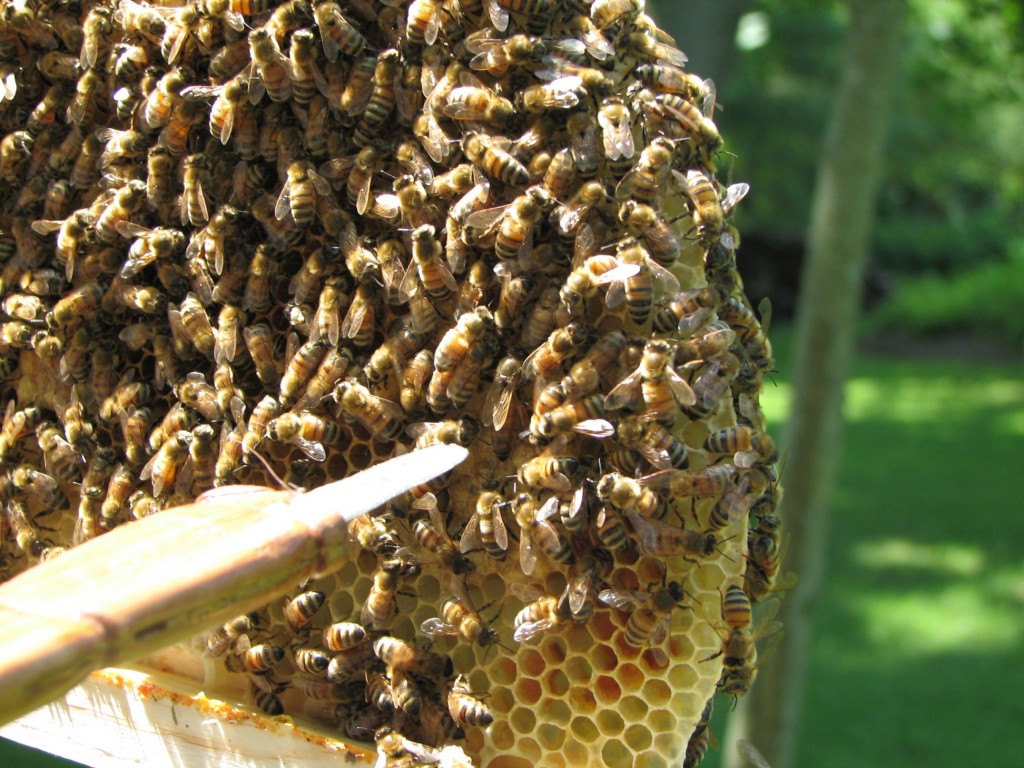
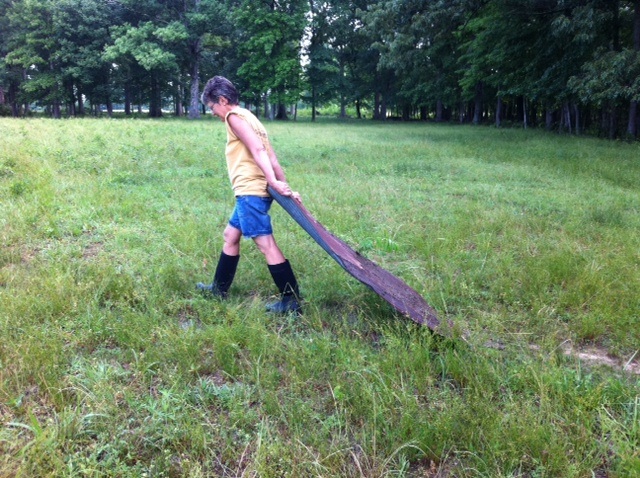
A Sucker for Ugly
My aesthetics are evolving. You know, when I first told Deb I wanted to keep bees, she wasn’t thrilled. Why? She didn’t want to see a line of towering white boxes on the hill in our yard. And I get that. I don’t like the white boxes either, so I painted my boxes a few different colors. I’ve settled on a couple of colors that I like, and now I paint all my boxes some variation of those. (Every now and then, I throw in a shade of blue that I’m not crazy about because Deb likes it. Gotta do it.)
However, I’ve started to like the way the Langstroth hives look unpainted. I like the way they weather…especially if the boxes are jointed together…because the joints weather a different shade than the flat parts.
All of this to say that since I first learned of top-bar hives (TBH), I’ve been drawn to the ugly ones. The ugliest ones. The very ugliest ones. None of those pretty hives for me.
Right now, I’m still buying some lumber, and I’m still using power tools. But TBHs are awesome because they can be built without power tools, and I’m working my way there. I think I’ll like the looks of the hives once I go completely powertool-less (I had to make up the punctuation of that last word…no dictionary recognizes what I’m trying to accomplish with it).
This most recent hive was constructed of cedar fencing. The roof is a piece of barn roofing that flew off our Kentucky barn. When we get back to the farm, I’m gonna scavenge the barn (which is falling down) for old siding and use it to build the next TBH iteration.
They may kick me out of my nice neighborhood for getting so ugly.

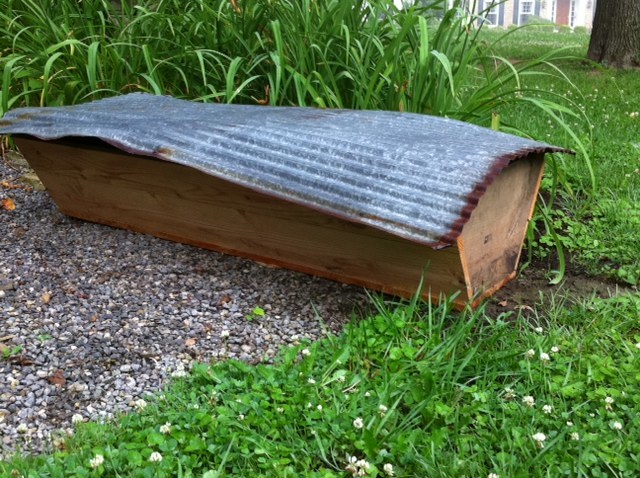
"Last Night as I Was Sleeping"
Last Night As I Was Sleeping
BY ANTONIO MACHADO
TRANSLATED BY ROBERT BLY
Last night as I was sleeping,
I dreamt—marvelous error!—
that a spring was breaking
out in my heart.
I said: Along which secret aqueduct,
Oh water, are you coming to me,
water of a new life
that I have never drunk?
Last night as I was sleeping,
I dreamt—marvelous error!—
that I had a beehive
here inside my heart.
And the golden bees
were making white combs
and sweet honey
from my old failures.
Last night as I was sleeping,
I dreamt—marvelous error!—
that a fiery sun was giving
light inside my heart.
It was fiery because I felt
warmth as from a hearth,
and sun because it gave light
and brought tears to my eyes.
Last night as I slept,
I dreamt—marvelous error!—
that it was God I had
here inside my heart.
